yogabuch / asanas / quadriceps stretch 1 on the wall
Contents
„Quadriceps stretch 1 on the wall“
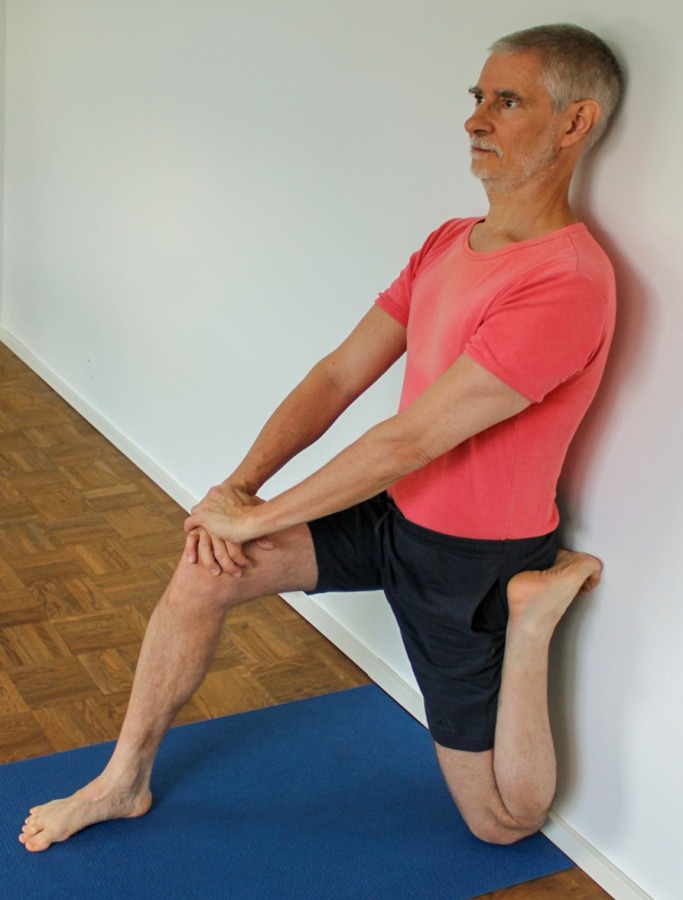
 instructions and details with working links as PDF for download/print
instructions and details with working links as PDF for download/print
Tue und lasse
not on plantarflexin..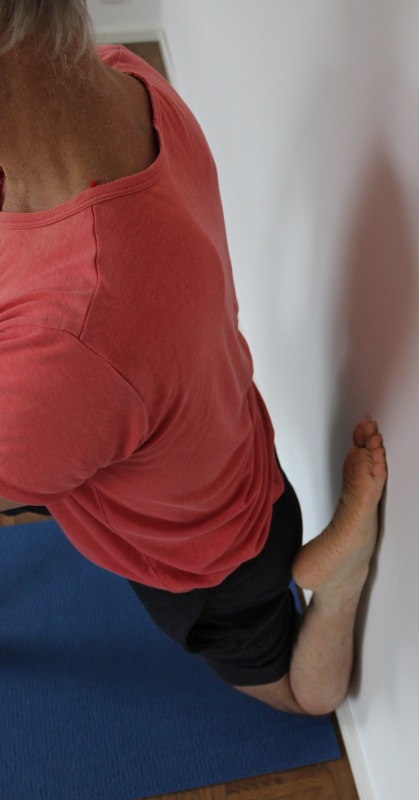 | .. but in slight dorsiflexion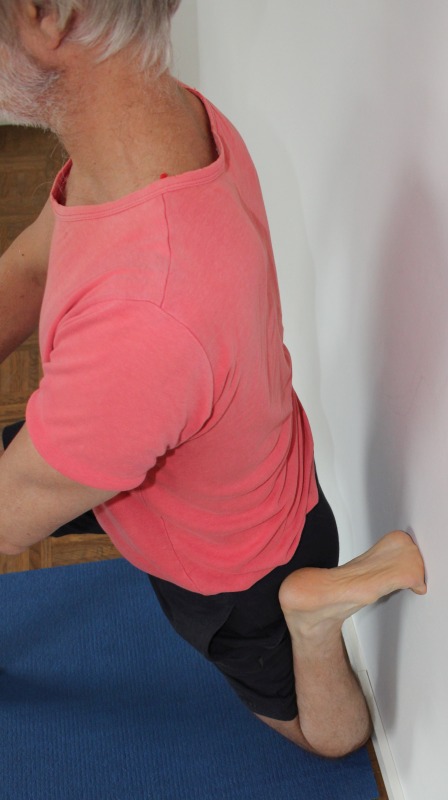 |
Feedback: We would love to hear what you think about this description, give us feedback at:
postmeister@yogabook.org
last update: 12/30/2018
Trivia name: Quadriceps stretch 1 on the wall
Level: A
- Classification: A
- Contraindication
- effects
- Preparation
- follow-up
- derived asanas
- similar asanas
- diagnostics
- Instruction
- details
- Variants
Classification
classic: functional exercise
physiological: stretching the quadriceps
Contraindication
In the case of facet syndrome, spondylolisthesis (slipped vertebrae) or spinal canal stenosis, care must be taken to ensure that the lumbar spine is not hyperlordosed. These disorders are therefore not an absolute contraindication, but they do require great care and full use of the pomus muscles, i.e. the most powerful hip extensor to avoid a hollow back. The upper body should only be raised as far as the pelvis can be straightened, as is the ideal posture, i.e. it must remain in line with the pelvis.
Effects
- (811) Stretching the quadriceps
- (816) Stretching the rectus femoris
- (871) Stretching the pronators of the ankle
- (971) Stretching the toe flexors
Preparation
As this is an elementary basic exercise, hardly any preparatory exercises can be given other than the following:
Generally synergistic, but only in terms of stretching the hip flexors(iliopsoas) located in the pelvis:
- hip opener 1
- hip opener 2
- warrior 1 pose
- upface dog
- urdhva dhanurasana (back arch)
- ustrasana (camel)
and other backbends with extension in the hip joint. The pomus muscles and other hip extensors must be used powerfully here to straighten the pelvis, which can be prepared with:
- utkatasana
- caturkonasana
- parsvakonasana
- counter
- warrior 2 pose
- purvottanasana
- urdhva dhanurasana
- eka pada variation of urdhva dhanurasana
- setu bandha sarvangasana
- eka pada variation of setu bandha sarvangasana
- warrior 3 pose
- ‚Backwards against the wall‘ variation of warrior 3 pose
and various other backbends The metatarsophalangeal joints must be flexed 90° dorsally, which is often quite difficult. Preparatory are:
and other various backbends
Follow up
If the lower back feels uncomfortably tense after the posture, help:
- parsva uttanasana
- balasana (virasana forward bend, child’s pose)
- parsva upavista konasana
- parivrtta trikonasana
- parsvottanasana
- Half lotus forward bend
- karnapidasana
derived asanas:
similar asanas:
Diagnostics (No.)
An excessively hollow back in this posture, despite all the strength applied, indicates shortened hip flexors. For the risks of a hollow back, see the FAQ.
(811) Quadriceps:
The cause of the inability to place the widely bent knee against the wall, or to bend it far enough to place the buttocks against the wall, is tension in the monoarticular vastii of the quadriceps. As described, this pose goes beyond a normal virasana and is roughly equivalent to virasana or supta virasana with the feet up.
(644) LUMBAR SPINE:
In this pose, problems of the lumbar spine or its musculature may become apparent FAQ.
Variants:
(P) supported on the shoulder of the supporter
Instructions
- Kneel with your back to the wall, shift your body weight onto one foot, bend the other knee wide and place it on the floor; place the foot of the leg kneeling on the floor with the ball of the foot on the wall at such a height that the sole of the foot is horizontal. Support yourself on your hands.
- Place the foot of the second leg pointing away from the wall on the wall at such a distance that the knee is bent at or slightly more than a right angle.
- Use the strength of the leg bent at a right angle topush the pelvis towards the wall and straighten it using the strength of the hip extensors (including the pomus muscles).
- Support yourself with your hands on the knee of the right-angled leg and use the strength of your arms to push your body away from the knee towards the wall.
Details
- The distance between the knee on the floor and the wall should be zero. Depending on the flexibility of the quadriceps, this may not always be possible. Choose the smallest possible distance at which the upper body can still be straightened halfway and the exercise does not have to be aborted due to lack of strength when straightening up. If you choose too great a distance, the posture will lose a lot of its effectiveness. This can possibly be compensated for to some extent by straightening the pelvis, but not for every distance. The appropriate distance of the knee from the wall depends on both the monoarticular vastii of the quadriceps and the rectus femoris. If the vastii are not mobile enough, the angle of the thigh to the floor will already be so small when the knee is against the wall that it will hardly be possible to hold the upper body upright for any length of time, even if the hip joints were in 0° flexion. However, as it is to be expected that the rectus femoris is no less restricted in its flexibility in these cases, the pelvis will be significantly tilted again (in flexion in the hip joint) in relation to the thigh (which is too flat), so that the angular distance of the pelvis from the horizontal may already be smaller than from the vertical and a sustainable straightening, especially without a hollow back, is completely impossible.
- Straightening the pelvis is of great importance for the effectiveness of the posture and the well-being of the lower back. If the knee is sufficiently close to the wall and the pelvis is straightened, a clear pull in the rectus femoris must be felt. The work of the gluteus maximus pomus muscles and their influence on the intensity of the stretch should be clearly noticeable.
- As the hip joint is a joint with a three-dimensional range of motion, the pelvis will flex in all three dimensions when the hip flexors are pulled. With a given amount of force applied, the total amount of deviation should always be the same; we can only decide where we direct it to or away from. Typically, the hip of the front-supporting leg with the knee joint bent at right angles must move backwards, inwards and downwards as a correction. A significant increase in the sensation of stretching is often felt during the correction.
- As in supta virasana and virasana, the lateral distance between the foot on the wall and the pelvis should be zero and the midline of the foot should be perpendicular to the wall. Tendencies to deviate in the form of the rotation of the thigh are propagated into the lower leg, so that there are almost always visible gaps here if no intervention is made. Correction is typically carried out by hand directly on the foot and may have to be carried out repeatedly or permanently. Only one hand is then available to support the other knee. A lateral distance between the foot and pelvis easily creates an endorotation of the lower leg in relation to the thigh in the knee joint.
- The upper body should be in extension of the pelvis. The back is not brought up to the wall as quickly as possible but the order in which the wall is reached is
- first the knee, as soon as the sum of the flexibility of the mono-and biarticular quadriceps does not make supporting yourself too strenuous.
- then the buttocks, if the pelvis can almost be straightened, there should be no noticeable hollow back.
- and finally the back and head, with the hip jointsextended: Knees, buttocks, back and head come slightly against the wall, the effect of the posture is exhausted, it then no longer needs to be practiced – except for control – instead, practice quadriceps stretch 2. This differs in several ways, more than the external impression suggests. If you do sports or other activities that occasionally or even regularly challenge the legs, you should still perform quadriceps stretch 1 from time to time as a control exercise, even once you have achieved full flexibility in this posture.
- As far as bending the knee joint and thus the flexibility requirement in the Vastii is concerned, this pose goes beyond virasana and supta virasana. While the limit of flexion in the knee joint is reached when the ischial tuberosities(virasana) or the buttocks(supta virasana) are on the floor and therefore at the level of the back of the foot, here you can reach past them and even past the heels all the way to the wall. Supta virasana is comparable to feet upright, but requires extreme flexibility and pressure resistance in the metatarsophalangeal joints.
- There is often a pronounced discomfort in the metatarsophalangeal joints. If the sole of the foot is horizontal, the flexibility of the metatarsophalangeal joints in the direction of dorsiflexion(extension of the toes) is not sufficient. Mobility requirements and discomfort are exacerbated if the ball of the foot is higher than the heel. If they are lower, this results in reduced flexibility requirements and reduced discomfort. However, it is not uncommon for the balls of the feet not to be positioned low enough to provide sufficient relief, in which case the dorsiflexion of the ankle is not sufficient. The solution could be to slightly increase the distance between the knee joint and the wall, which reduces the required dorsiflexion. However, the achievable stretching effect should then still be sufficient and the pelvis will probably have to be straightened more strongly.
- Do not rest your forearms on your thighs, as this tilts the pelvis forward in the hip joints and contradicts the necessary straightening of the pelvis in the hip joints.
with the foot extended
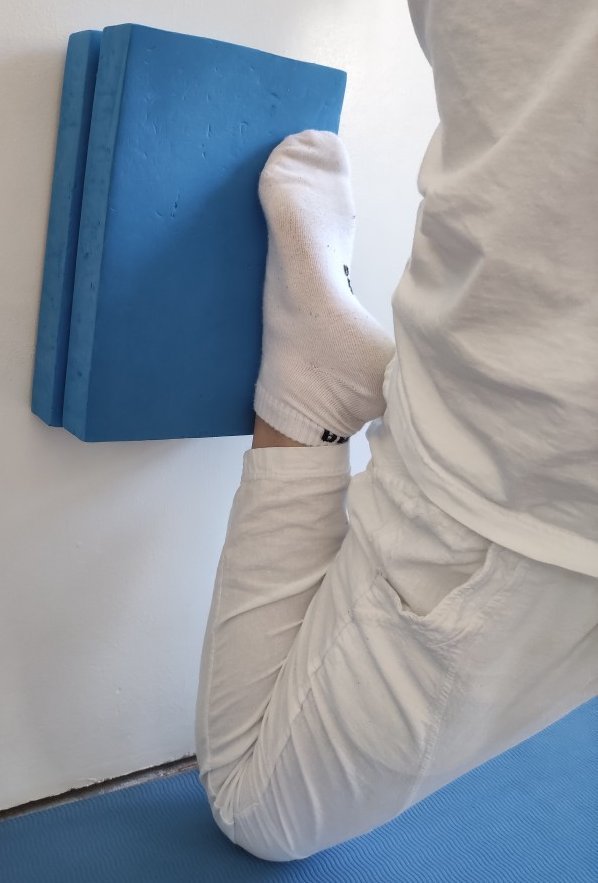
Instructions
- Take the pose as described above, but with the plantarflexed (stretched) ankle instead of the dorsiflexed ankle. Use an appropriate number of shoulder plates or similar between the foot and the wall so that the distance between the ankle is approximately the same as in the standard version.
Details
- The standard version cannot or should not be performed in the case of the disorders listed above under contraindications. This variation should still be possible.
- In order to achieve a comparable effect to the standard version with the foot upright, the ankle must be artificially distanced from the wall. Experience has shown that wooden or cork blocks are too hard on the bony back of the foot, so that a correspondingly large number of softer shoulder plates are recommended here. The hardness would also encourage the ankle to move into adduction.
(P) supported on the shoulder of the supporter
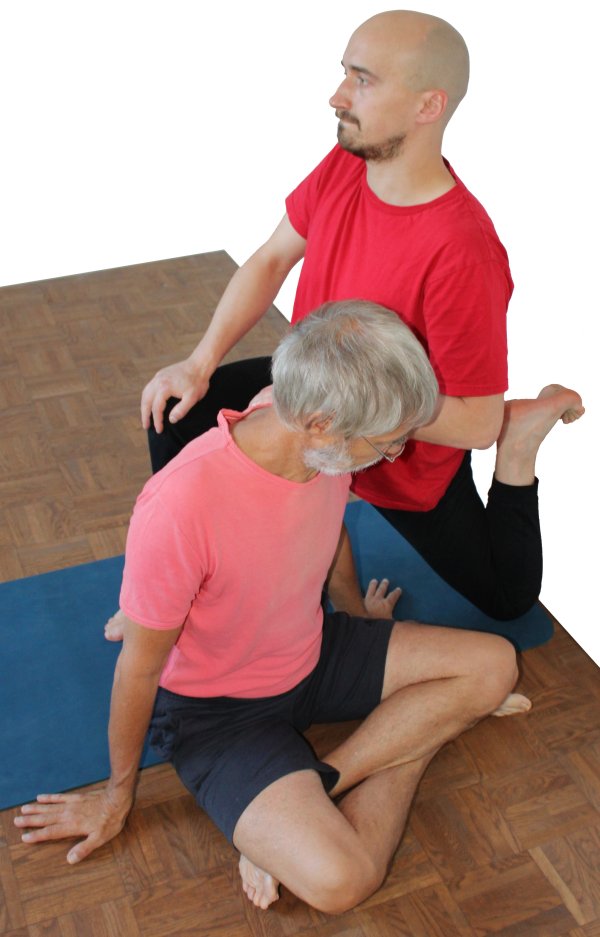
Instructions
- Take the pose as described above. The supporter sits on the side of the strongly bent leg with their foot on the wall and offers their shoulder to the performer for support.
Details
- If the supporter sits facing the wall and the performer, they can monitor and correct the execution of the posture at the same time.
(P) Support for taking the pose

Instructions
- Adopt the posture described above.
- If the knee cannot be moved close enough to the wall under its own power, the supporter sits in front of the performer’s leg to be stretched and performs the following manoeuvre.
- The performer tilts forwards in the hip joints to relieve the rectus femoris to be stretched.
- The performer then rests their hands on one of the supporter’s shoulders in order to completely relieve the leg to be stretched.
- The supporter uses both hands to push the leg to be stretched as far as possible towards the wall.
- The performer takes back the support on the shoulder and puts full weight on the leg to be stretched again.
- The supporter then straightens the pelvis and moves it towards the wall.
Details
- This support often enables less mobile people to reach full intensity. It is important that the leg to be stretched is completely unloaded so that the supporter can lift it a little and push it towards the wall. If the supporter feels a rather hard resistance against which the knee cannot be moved any further towards the wall, this will be the limit of the dorsiflexion ability of the ankle. In this case, the foot must be placed a little higher, which should allow further movement of the knee towards the wall. In contrast to the ankle joint, the limit felt here is easily recognisable as soft-elastic, i.e. muscular.
